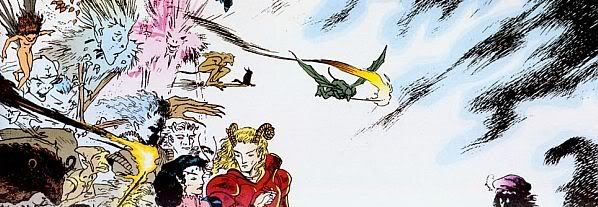The main reason why I bring it up, especially in a Shakespeare blog is the arch pertaining directly with "A Midsummer Night's Dream". In it, Morpheus contracts Shakespeare for two plays because of the man's amazing skill for story. One of the two he produces is the aforementioned "Dream". Shakespeare then puts on the play for the Titania, Auberon, Puck, and many other creatures, who have come from the faerie kingdom to watch. Wikipedia reads "Puck greatly enjoys the play and repeats the theme of the story that while the play does not directly reflect history or even some of the personalities of the characters it is still considered a true reflection of 'reality'. (In reality Puck is described as being a psychotic murderer and not a merry wanderer of the night.) Titania takes an interest in Shakespeare's son Hamnet, who plays a small role in the play."

Drawn by Charles Vess, Colored by Steve Oliff, owned by DC
The work inspired a meditation on art here. The article, written by Matthew Cheney of Gestalt Mash, describes the importance of art and the artist:
"What, then, is authentic and meaningful in art? What is art’s value and purpose? Is there something other than just entertainment — a diversion to kill some time — here?
Meaning is produced not by authenticity, but by representation. Questions of truth and fact come up many times in this issue of Sandman, and Dream himself addresses the question toward the end, when Lord Auberon says, “This diversion, though pleasant, is not true. Things never happened thus,” and the Sandman replies, “Oh, but it IS true. Things need not have happened to be true. Tales and dreams are the shadow-truths that will endure when mere facts are dust and ashes, and forgot.” Dream made his bargain with Shakespeare as a way to keep old stories alive, to pass along versions of truth from era to era, reality to reality — to escape the dust of memory.
Representations do not have to be authentic to be true, nor does authenticity create durability. Long-lasting art can be as artificial as one of Shakespeare’s most artificial plays, A Midsummer Night’s Dream, a play full of rhetoric and whimsy and fantasy. Such things allow a distance from the stuff of life, and within that distance we can find the objectivity to discern truths otherwise invisible to us. Artists risk loneliness and devastation when they delve into that distance, but the result can be a work — a truth — for the ages."
Myth is as endurable as the universe itself. Even if our warehouses of tradition, culture, and stories were washed away in the sands of time, there will be somebody else out there in the cosmos writing the same stories. They are caught in the wind, on the lips of children, in the fabric of stardust.
No comments:
Post a Comment